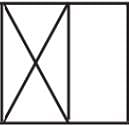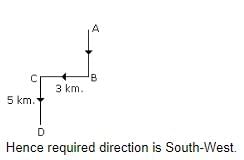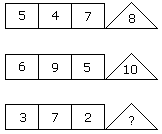SSA Chandigarh JBT Mock Test - 2 - SSA Chandigarh MCQ
30 Questions MCQ Test SSA Chandigarh JBT Mock Test Series 2025 - SSA Chandigarh JBT Mock Test - 2
Which one of the following is the principal source of information on Ashoka’s campaign against Kalinga?
Magasthenes refers to the rule of Heracles’ (Vasudeva Krishna’s) daughter who was assigned villages to rule in Southern region, and who was probably the founder of Pandya kingdom. Identify her.
Assertion A: Slavery was practised widely during the Chola empire.
Reason R: Rajaraja invaded Cheras, Pandyas, and Ceylon to bring the trade with south-east Asian countries under his control and open the sea routes to China.
Which statement on the Vijayanagar judicial system is incorrect?
Which layer of the Earth exhibits plasticity, allowing tectonic plate movement?
Which of the following latitudinal lines is also known as the Antarctic Circle?
Consider the following about the rock systems of India:
1. The Archaean rocks are found in the Deccan Peninsula and parts of the North-east.
2. The Dharwar rocks are rich in iron ore.
Which of the above statements is/are correct?
The Koel Karo Hydropower Project is a joint venture between India and which neighboring country?
Which one of the following is the oldest mountain range in India?
The lower Gangetic plain is characterized by a humid climate with high temperature throughout the year. Which one among the following pairs of crops is most suitable for this region?
Four positions of a dice are shown below. What number must be at the bottom face when the dice is in the position as shown in the figure(iii)

Find the number of triangles in the given figure.

In the following question assuming the given statements to be true, find which of the conclusion among given conclusions is/are definitely true and then give your answer accordingly.
Statements:
L > F = S < T ≤ Q < P
Conclusions:
I. F < Q
II. L > S
III. T < P
Which of the following is not a linear inequality?
If 'orange' is called 'butter', 'butter' is called 'soap', 'soap' is called 'ink', 'ink' is called 'honey' and 'honey' is called 'orange', then which of the following is used for washing clothes?
Statements: All A are B. Some B are C. All C are D.
Conclusions: – 1) All D are C. 2) All D are A. 3) Some D are B.
Ram and shyam are two friends talking with each other. The shadow of Ram falls on the right side of Shyam. If ram is facing north then the direction in which Shyam is facing.
Directions to Solve
In each of the following questions find out the alternative which will replace the question mark.
Question -
Flow : River :: Stagnant : ?
Direction: If a Paper (Transparent Sheet ) is folded in a manner and a design or pattern is drawn. When unfolded this paper appears as given below in the answer figure. Choose the correct answer figure given below.
Find out from the four alternatives as how the pattern would appear when the transparent sheet is folded at the dotted line.
Question Figure
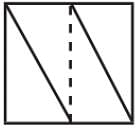
Answer Figure
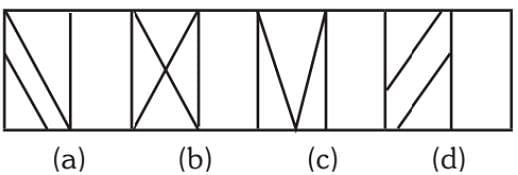
A man walks 5 km toward south and then turns to the right. After walking 3 km he turns to the left and walks 5 km. Now in which direction is he from the starting place?
A introduced B as the son of the son of the father of her uncle. How is A related to B.
The rows and columns of the left matrix have been labelled as 0, 1, 2, 3, 4 and F, G, H, I, J, whereas those of the right matrix are 5, 6, 7, 8, 9 and A, B, C, D, E. Find the correct row-column pairs out of these matrices that decode to the word - 6TRK
In each of the following questions, you are given a figure (X) followed by four alternative figures (1), (2), (3) and (4) such that figure (X) is embedded in one of them. Trace out the alternative figure which contains fig. (X) as its part.
Find out the alternative figure which contains figure (X) as its part.

Directions : Study the following information carefully and answer the questions which follow:
There are five men, Avinash, Keshav, Subodh, Roshan and Hemant. The one who is tallest is not the youngest. Keshav is older than only Hemant. Subodh is older than Roshan but just shorter than him. Only one person is taller than Roshan. Avinash is shortest while younger than only Subodh and Roshan. Only two men are shorter than Subodh.
Q. If the five men are made to stand in a line according to their height, first in ascending order, then in descending order, then whose position will remain the same in both the arrangements?




